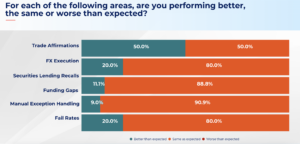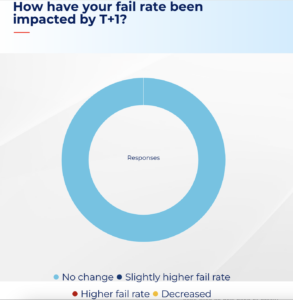Organisations within North America have been pleasantly surprised with the transition to T+1, as comprehensive preparation and testing paid dividends for the market switch.
With a fortnight now elapsed since T+1 go-live in North America, figures from leading institutions within the securities industry convened last week to take stock on the move so far, meeting with peers on the T+1 War Room initiative launched by Global Custodian and The ValueExchange, in partnership with FIS. 
The general consensus of the conversation was one of pleasant surprise and mutual recognition of the great work done in the lead-up to the switch to ensure the smoothest of transitions.
“We did a series of dress rehearsals and worst-case scenario planning in the tee-up to go-live,” one custodian said. “Part of that was doing volume and performance testing, where we did two and four times our high watermark of volume at the critical times of 7-11pm, where client instructions may be coming in. We did that on two separate occasions to just see if there were any issues if we needed to pivot, which we didn’t need to.”
The discussion then turned to a poll, which asked how each organisation is performing with regards to certain processes. The results revealed that 100% of firms founds they were doing better than they expected when assessing trade affirmations, FX execution, and securities lending recalls.
In the lead up to go-live, the DTCC had published same-day affirmation rates of 74.95% and 83.5% for March and April, respectively, which may have been a worry for those operating within the market and resulted in a more cautious outlook for the switch.
“We went in with a very conservative view around expecting an increase of fails, just due to the fact that we were expecting some friction around the affirmation process in the immediate aftermath of go-live,” a prominent broker-dealer said during the conversation. “To be honest, we were pleasantly surprised with the affirmation rates that were well above what the DTCC projected and also what we projected internally.”
 And those affirmation figures for the initial week were impressive. The first three days saw incrementally increasing affirmation rates – 92.76%, 94.55% and 94.66%, respectively – while fail rates stayed consistent with those seen in a T+2 environment over day one and two.
And those affirmation figures for the initial week were impressive. The first three days saw incrementally increasing affirmation rates – 92.76%, 94.55% and 94.66%, respectively – while fail rates stayed consistent with those seen in a T+2 environment over day one and two.
However, affirmations then dipped to 91.26% on day four, while fails saw an uptick over days three and four. What is important to remember though, is that within the opening week there was both a double settlement day – whereby T+2 and T+1 transactions were settling together along with the MSCI rebalancing, an event which many believed would be a stumbling block for the new operational setup for US equities.
The numbers have since edged back up to the 95% mark and held there.
One custodian on the call, who reported increased volumes of 75% on double settlement day, noted: “We’ve been pleasantly surprised with the level of engagement and adoption. Our affirmation rates are much higher and our fail rate has been consistent – we haven’t seen an uptick. Our fail rates remain the same pre-T+1 to today.
“From a custodial perspective, we certainly will probably never achieve 100% affirmation. We did cross over the 90% threshold, which is groundbreaking for custodians. To achieve 100%, it does require broker-dealers sending confirms, clients sending instructions and the two aligning together.”
One curveball could have been self-affirmation, whereby custodians may not have sight of affirmed trades. When asked unintended consequences from the new volumes of self-affirmation, one custodian responded: “We certainly welcome self-affirmation and it helps the entire process. We have the ability to marry client instructions to the affirmed confirm to avoid duplication, as many of the other providers do and that alleviates concerns in that model.
“I think it comes down to education and where certain tools are being used, if they have other products that are being leveraged, lending, for example, well then maybe you need to have handoff to your lending provider for what’s been traded versus waiting for the custodial instruction to hand off. Or FX – if we’re doing a custodian FX instruction and that has been self-affirmed and you have the inability to send the instruction timely and you’re going to miss an FX deadline, maybe we need to look at using our online portal to book those.”
When considering how to get to 100% affirmation, one area of feedback we received was that DTCC’s ALERT “needs to be reviewed and updated”. One speaker noted: “There’s a lot of incorrect and bad data out there that then has a knockdown effect on confirms that are either not coming in or are getting rejected.
“We saw a number of different issues where confirms were going up with a place of settlement as US versus DTC, or Euroclear versus DTC, or incorrect account numbers in different fields that were causing rejection.”
These issues would mean that custodians won’t be able to affirm trades.
Not out of the woods just yet
While early signs have been largely positive, and institutions begin to wind down their 24/7 support, there is still an expectation of challenges in the future.
“It may be a little too early to say what the knock down effect on lending will be,” one executive pointed out. “A lot of the areas that we thought were going to be particularly problematic, especially from a European and Asia client base, haven’t really materialised.
“However, I think there’s still pockets of challenges. As mentioned, the Asia-based clients on Friday evening into their Saturday morning could be super problematic with labour laws being what they are in some of the countries that prohibit working on Saturday. It will be interesting to look at Friday week two numbers and what they show.”
A figure from another organisation then explained that to normalise its fail rates, it has seen an initial uptick in borrows – a practice it hopes to move away from in the coming months.